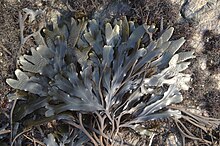Fucus
| Fucus | ||||||||||||
|---|---|---|---|---|---|---|---|---|---|---|---|---|

Sawwrack ( Fucus serratus ) |
||||||||||||
| Systematics | ||||||||||||
|
||||||||||||
| Scientific name | ||||||||||||
| Fucus | ||||||||||||
| L. |
Fucus is a seaweed genus of the brown algae .
description
The Fucus species are stately, perennial macroalgae. Its leathery, coarse, brown-green thallus is flattened, forked in one plane and traversed by a central rib. It reaches up to 50 cm in length. At the base it is firmly connected to the ground with a disc-shaped adhesive element. In older specimens, the midrib forms a solid stalk after the thallus margins have been lost. Often there are gas bubbles that give the seaweed buoyancy in the water.
Multiplication
The Fucus rods are always diploid . During the ripening period, the mostly swollen fruiting bodies, so-called receptacles, form at the ends of the thallus, on which the gametes are released from organs sunk in the shape of a pitcher (conceptacles). In most species, male and female conceptacles are distributed among different specimens ( diocyte ). Some species are monocular with male and female sexual organs on the same thallus. Some of the monoecious species are hermaphroditic ( e.g. the spiral wrack ), others are sexually separated.
The male gametes ( zoospores , swarmers) are formed by meiosis on branched antheridia within the conceptuals . The egg cells arise on short-stalked oogonia . When the algae dry out at low tide , the gametes are pushed out to the surface and washed off and mixed with the rising tide. The egg cells attract the male sex cells with the help of the hydrocarbon fucose rate . After fertilization and fusing of the cell nuclei ( karyogamy ), the zygote sets itself , germinates and forms a new diploid thallus.
After the main ripening period, the fruiting bodies are renewed.
Occurrence
The Fucus species are common in the cool waters of the North Atlantic and North Pacific . In the North Sea and Baltic Sea , they occur mainly on stony coasts. They colonize solid ground, such as harbor walls, rock tidal flats or mussel beds from the upper to the lower tidal zone . The individual species prefer different height zones: the spiral wrack occurs highest up, followed by Fucus guiryi , bladder wrack and saw wrack below .
Systematics



The genus Fucus was established in 1753 by Carl von Linné in Species plantarum , Volume 2, p. 1158. The genus name Fucus is a Latin derivation from Greek: Phykos (Tang). The species Fucus vesiculosus L. was determined as the type species (lectotype). The genus belongs to the order of the Fucales . According to Guiry (in Algaebase 2012) it currently comprises 15 species:
- Fucus ceranoides L .: It occurs in the north-east Atlantic from Spitzbergen to Portugal and Spain and is also native to the North Sea.
- Fucus cottonii MJWynne & Magne: It occurs on the coasts of Norway, Great Britain, Ireland and France.
- Fucus distichus Linnaeus: It is widespread in the North Atlantic and North Pacific (Greenland, Japan, in North America from California to Canada and Alaska, in Europe in Scandinavia, Great Britain and Ireland)
- Fucus evanescens C. Agardh: It is widespread in the North Atlantic and North Pacific and is also found in the Baltic Sea.
- Fucus gardneri PCSilva: It is distributed on the coasts of North America and in the Bering Sea.
- Fucus guiryi GIZardi, KRNicastro, ESSerrão & GAPearson (Syn. Fucus spiralis var. Platycarpus ): It occurs in the north-east Atlantic from Great Britain and Ireland to Morocco.
- Fucus lagasca Clemente: (distribution in algaebase not specified)
- Fucus parksii Gardner: Endemic to California.
- Fucus radicans L. Bergström & L.Kautsky: Endemic to the Baltic Sea on the coast of Sweden.
- Saw wrack ( Fucus serratus L.), with a serrated edge of the thallus, without swollen prescriptions: distributed in the North Atlantic from Spitzbergen to the Canary Islands and in North America. It is also found in the North Sea and the Baltic Sea.
- Fucus setaceus Poiret: (distribution not specified)
- Fucus spataeformis Esper: (distribution not specified)
- Spiral wrack ( Fucus spiralis L.): Distributed in Europe from Scandinavia to the Canary Islands and Morocco, also in the North Sea and Baltic Sea. In North America on the coasts of the Atlantic and Pacific.
- Bladderwrack ( Fucus vesiculosus L.), of which there is also a blisterless form: distributed in the North Atlantic from Northern Europe, the North and Baltic Seas to Morocco, in America from Canada to the Caribbean and Brazil.
- Fucus virsoides J.Agardh: endemic to the Mediterranean (Adriatic)
use
Sawweed and bladderwrack are used in Ireland and France to make seaweed extract for cosmetic products. The dried algae are also used as seaweed baths in thalassotherapy .
swell
- Michael Guiry: The Seaweed Site: information on marine algae: Fucus , accessed March 12, 2012 (sections description, usage)
- Michael D. Guiry, GM Guiry: Fucus In: Algaebase - World-wide electronic publication, National University of Ireland, Galway , accessed March 12, 2012 (section systematics)
- P. Kornmann, PH Sahling: Sea algae from Helgoland - Benthic green, brown and red algae. Biologische Anstalt Helgoland, Hamburg, 1983. ISSN 0017-9957 , pp. 162-167. (Section description)
Individual evidence
Web links
- Video: fertilization biology in Fucus (Phaeophyceae) - dioecious and monoecious . Institute for Scientific Film (IWF) 1991, made available by the Technical Information Library (TIB), doi : 10.3203 / IWF / C-1747 .


